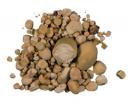 Diseases 2.0 – Bringing you the latest updates on disease pathophysiology and treatment
Diseases 2.0 – Bringing you the latest updates on disease pathophysiology and treatment
Commentary By David Goldfarb, M.D. Professor of Medicine, NYU Medical Center, Chief Nephrology Section VA New York Harbor
At the recent meeting of the National Kidney Foundation in Dallas, Dr. Orson Moe reviewed the links between diabetes and uric acid stones . Uric acid stones are most often caused by low urine pH. With a low urine pH, even relatively little uric acid can precipate, as it forms the protonated form, which is poorly soluble. At higher pH values, uric acid dissociates to the urate anion and the proton is titrated by the base. This dissociated form is quite soluble. With urine pH values of 6.5, even high amounts of urinary uric acid will not be associated with stones. Hyperuricosuria is a less important risk factor. So while patients with hyperuricosuria may have stones, urinary alkalinization is usually a preferred treatment as compared with allopurinol. If uric acid excretion is reduced by this xanthine oxidase inhibitor but urine pH is not raised, uric acid stones may still form. Allopurinol is best indicated in patients who have trouble alkalinizing the urine or continue to have stones despite alkalinization. Hyperuricosuria is seen with some myeloproliferative disorders such as polycythemia vera, high animal protein intake (equivalent to high purine intake). Low pH is seen in states of chronic diarrhea (ileostomy, colitis, Crohns) and diabetes.
The links between diabetes and low pH are being studied. Higher body mass intake is associated with lower urine pH, and this might be explained by higher BMI being associated with insulin resistance. In fact, the more features of metabolic syndrome become evident in an individual patient, the lower the urine pH. Insulin is important in ammoniagenesis, and recent data from U. Texas Southwestern indicate that insulin resistance is associated with impaired ammoniagenesis. In this case, there is less urine ammonia available to accept protons and with less urine buffer, and pH is lower. Some studies suggest that patients with uric acid stones also have increased net acid excretion, suggesting a dietary component of greater acid ingestion. Although research suggests that insulin directly impairs ammoniagenesis, new data from Southwestern are exploring the possibility that the effect is mediated by renal fat. In this hypothesis, increased BMI is associated with deposition of fat in the kidney. MR spectroscopy techniques developed at UT Southwestern are measuring renal fat deposition and attempting to correlate the imaging studies with fat stained in kidney biopsies. This lipotoxicity in the kidney may correlate with impaired insulin effect and impaired ammoniagenesis.
The treatment of recurrent uric acid stones is alkalinization of the urine. This is best accomplished with potassium citrate. Sodium citrate (e.g. Shohls solution or Bicitra) should be reserved for patients with hyperkalemia or GI intolerance as the sodium load, though often tolerated, may increase urine calcium excretion. Potassium citrate (20-30 meq) can be given with liquids or food to minimize GI intolerance. It is usually given 2-3 times per day to achieve round-the-clock alkalinization for patients with stones in place. It can be given once a day (at night) or even every other day for prevention in patients who do not currently have stones.
1: Bobulescu IA, Dubree M, Zhang J, McLeroy P, Moe OW. Effect of renal lipid accumulation on proximal tubule Na+/H+ exchange andammonium secretion.Am J Physiol Renal Physiol. 2008 Apr 16; [Epub ahead of print]PMID: 18417539
2: Sakhaee K, Maalouf NM. Metabolic syndrome and uric Acid nephrolithiasis.Semin Nephrol. 2008 Mar;28(2):174-80.PMID: 18359398
3: Maalouf NM, Cameron MA, Moe OW, Adams-Huet B, Sakhaee K. Low urine pH: a novel feature of the metabolic syndrome.Clin J Am Soc Nephrol. 2007 Sep;2(5):883-8. Epub 2007 Aug 16.PMID: 17702734
4: Cameron MA, Baker LA, Maalouf NM, Moe OW, Sakhaee K. Circadian variation in urine pH and uric acid nephrolithiasis risk.Nephrol Dial Transplant. 2007 Aug;22(8):2375-8. Epub 2007 May 3. No abstractavailable.PMID: 17478488
5: Cameron MA, Maalouf NM, Adams-Huet B, Moe OW, Sakhaee K. Urine composition in type 2 diabetes: predisposition to uric acidnephrolithiasis.J Am Soc Nephrol. 2006 May;17(5):1422-8. Epub 2006 Apr 5.PMID: 16597681

One comment on “Diseases 2.0: Uric acid stones linked to diabetes”
A part of the pathogenesis of kidney stones seems linked to increased oxidation stress surprising because two separate pubmed articles have shown that antioxidant decrease stone formation EGCG was the antioxidant derived from green tea extract
Kidney news
Comments are closed.